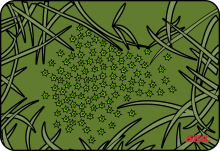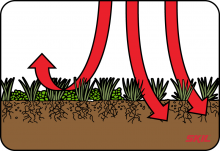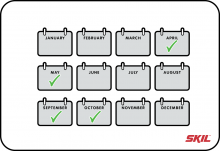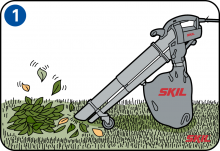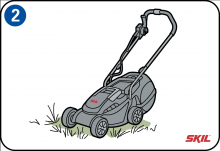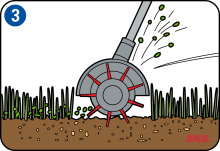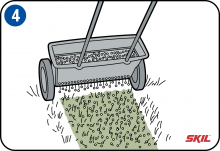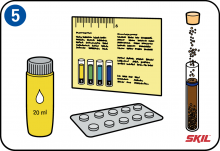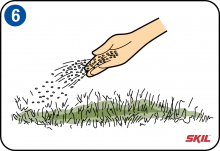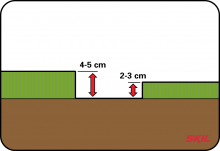-
Causes of moss forming
Moss on your lawn is a common source of frustration. It can cause real problems if the moss gets the upper hand over the grass. There are various reasons why moss may form: soils that are too acidic (low pH value) or too moist, infertile soils as well as grass that is cut too short, exacerbate the problem. -
Why remove moss?
If you want to keep your lawn attractively green and allow the grass to grow nicely, you need to remove moss and prevent moss forming in the future. Removing the moss from your lawn will give the grass access to more light and oxygen. The grassroots will be better able to take up the nutrients in the soil, too, which benefits the health of your lawn. -
When should you remove moss?
There are two major growing periods for grass over the year: one in the spring (April/May) and one in the autumn (September/October). If you remove moss before these periods, the grass will be able to recover when it grows. Depending on the condition of the grass, moss can be removed from the lawn once or twice a year. If you see a lot of moss forming in the course of the year after removing moss, you can repeat the process a second time. If you only remove moss once a year, you should preferably do so in April.
Take care to remove moss on a dry day, when it’s less likely to stick to the grass. Spring can sometimes start early and you can remove the moss in March. Keep an eye on the weather. -
Step 1: Remove all leaves and all other detritus from your lawn
Start by removing leaves and other detritus, such as twigs, from your lawn. A leaf blower will get the job done quickly. As well as (dead) leaves, a leaf blower can also suck up and cut up small pruning waste. This is deposited in a bag so it can be easily thrown away. -
Step 2: Mow the lawn
Mow the lawn after it starts to grow to a height of 2-3cm (about 1 inch). If the grass has barely grown, you don’t need to mow. -
Step 3: Remove moss or scarify
Use a special scarifier or lawn raker to remove the moss. A lawn raker will easily remove the moss from the lawn. Then, simply rake together the moss and take it away. The moss will be harder to remove in some places. You can use the lawn raker twice there, first in one direction and then at right angles. -
Step 4: Seed
When you remove moss, you’ll be left with some bare patches on the lawn where there used to be a lot of moss. You can rectify this by sowing grass seed. Grass germinates best when the temperature is not too high. Keep the lawn moist until the grass seed has germinated and refrain from walking on newly germinated blades of grass, which are easily damaged. Bear in mind that birds love grass seed. You can scare them away by planting a piece of aluminium foil on a stick at various points on the lawn. -
Step 5: Liming (winter)
The acidity of the soil – the pH value – is a very important factor for grass growth. You should be able to get a soil test kit from a garden centre.
If the pH value is too low the grass won’t be able to take up all the nutrients it needs, so it’ll grow more slowly. That gives moss the chance to grow between the grass. Liming will increase the pH value of the soil, making it less acidic. Use special lime for lawns, spreading it evenly at the onset of winter. You may want to repeat the process in mid-winter. You can lime even when there is snow on the ground. The lime will seep into the soil when the snow melts. -
Step 6: Fertilising
Every lawn needs nutrients. With that in mind, you should fertilise your lawn around 6 weeks after liming. This provides added protection against diseases, helps the grass recover faster and creates a healthier, greener lawn. The denser grass growth also reduces the risk of moss forming.
Various types of fertiliser are available. They can be split into two main groups: organic fertiliser and artificial fertiliser. Artificial fertiliser is cheaper than organic fertiliser and contains all the minerals the lawn needs. Organic fertiliser only contains natural nutrients and it works longer than artificial fertiliser. Take note that most fertilisers contain substances that are harmful to children and pets. With this in mind, you should preferably keep children and pets away from the lawn for a few days to allow the fertiliser to penetrate into the soil. Always follow all instructions on the product packaging. -
Preventing moss forming on your lawn
Prevention is always a lot better than cure, of course. You can add a few things to your standard lawn maintenance routine to minimise future moss forming.
Make sure you regularly remove leaves, pruning waste and other stuff from your lawn. This will ensure the grass has more oxygen, destroying the moist, shady environment moss loves so much.
Mow the lawn regularly (as long as it is growing at least weekly), but don't cut it too short. If yours is an ornamental lawn or it’s in the shadow for a large part of the day, mow it to a height of 2-3cm (about 1 inch). If you have more of a play lawn for children or pets, you can let it grow a little longer. Set the mowing height to 4-5cm (1.5-2 inches).
If you spread lime every year at the onset of winter and in mid-winter, the pH vale of the soil will not tend to fall too low. Run a soil test to find out the pH value before you begin.
Moss likes to grow in the shade. If there are shrubs or trees that create a shaded area on your lawn, you may consider pruning them a little more to let in more sunlight.

